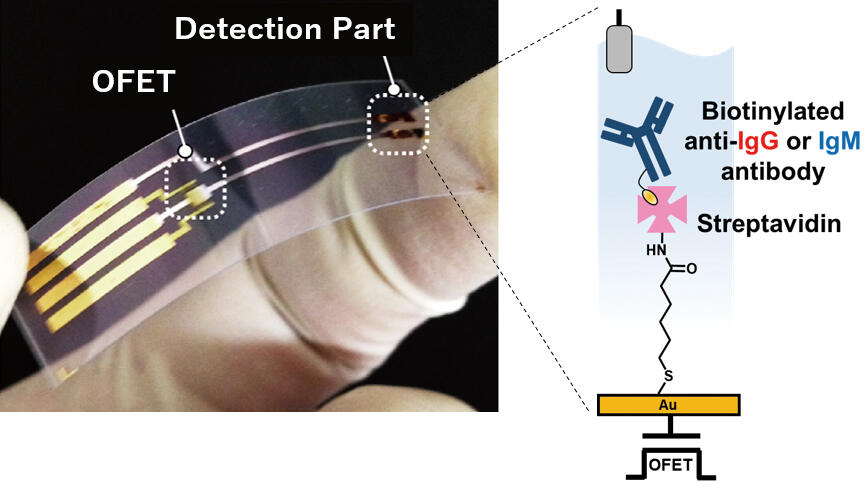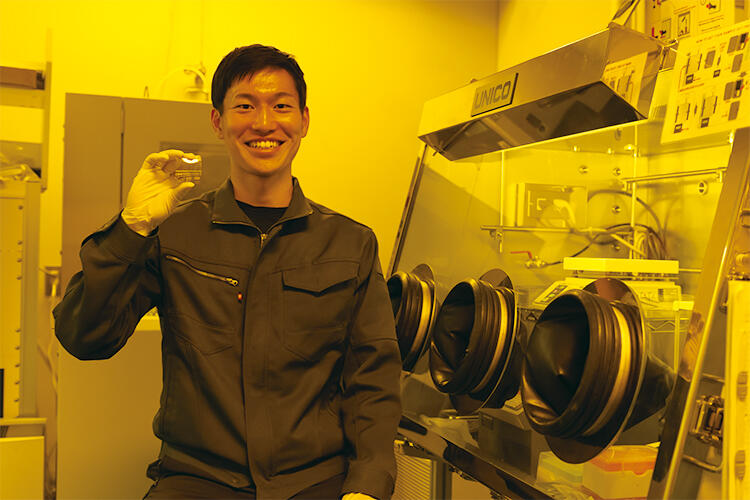Innovative organic transistor-based biosensors show potential as compact, inexpensive, and sensitive portable devices for medical diagnostics in the fight to contain the new corona virus.
Birth of extended-gate OFET biosensor
"We first demonstrated the potential applications of organic field effect transistors (OFET) for reliable immunosensing in 2014 in a paper published in Applied Physics Letters [1]," says Tsuyoshi Minami, an associate professor specializing in applied supramolecular chemistry at UTokyo-IIS. "We fabricated so-called 'extended-gate' OFETs to mitigate degradation of OFET devices when immersed in aqueous solutions. It was a major innovation and our paper was one the most accessed publications in the Biophysics and Bio-Inspired Systems in APL for 2014 to 2016 [2]."
Specifically, the extended gate sensing region consists of a gold film evaporated onto a flexible plastic (polyethylene naphthalate (PEN)) enabling its surface to be biologically functionalized. Notably, this 'flexible biochemical sensor' is separated from the main transistor part of the whole structure, which is not exposed to liquids during measurements.

Extended gate OFET biosensors evolve
The early extended gate OFET devices were successfully used to detect biotinylated immunoglobin G (IgG). "The important features of our biosensing approach is that they operate at low voltages of less than 3V and are small and inexpensive compared with conventional enzyme-linked immunosorbent assay (ELISA) protocols," explains Minami. "Also the devices can be fabricated using printing technology. There are many opportunities to innovate and expand this research, for example, into the realm of flexible and wearable electronics and wireless communications."
His group also functionalized their OFET with enzymes to detect biologically benign ions. For example, nitrate reductase on their OFET allows us to detect a nitrate ion in human saliva [3]. More recently, Minami and his colleagues reported on the use of their devices to detect a wide range of chemicals by functionalizing the extended gate sensors with 'artificial receptors' [4]. "This series of experiments demonstrated the possibility of combining host-guest chemistry with our devices," explains Minami. "We functionalized our OFETs with artificial receptors for electrically detecting a wide range of targets including organic and inorganic ions and proteins." Specific targets-receptor pairs included copper ions and nitrilotriacetic acid (nta); mercury ions and thiolated dipicolylamine (dpa); histamine and 5-carboxy-1-pentanethiol (CPT); and fluorine contamination in water with a phenylboronic acid (PBA) receptor.
Detection of proteins to combat COVID-19
ELISA is currently widely used for COVID-19 testing. This method consists of a complicated four step process consisting of an antibody, analyte, a secondary antibody with an enzyme. Furthermore, it can take between hours to days for the results to become available.
In contrast the so-called "label-free" technology developed by Minami and colleagues is not only simple, portable, and inexpensive but also fast, with the results known within minutes. "We functionalize the gold surface of the extended gate electrode sensing area by a self-assembly process," says Minami. "We immobilize anti-IgG antibody on gate electrode via the streptavidin-biotin conjugation. This enables the detection of IgG."
Initial experiments are promising with titration results showing a negative shift of the transfer curve of the OFET with increasing the target IgG concentration, and a detection limit of 0.62μg/mL, which is approximately 4nM.
"I am confident that our extended gate OFET biosensors will play an important role in containing the spread of COVID-19," says Minami. "I am collaborating with industrial partners to take this technology from the lab to real-life applications in society."

Master Course 2nd Koichiro Asano of Minami Lab., holding an OFET in his right hand
References
[1] Tsukuru Minamiki et al, Accurate and reproducible detection of proteins in water using an extended-gate type organic transistor biosensor, Appl. Phys. Lett. 104, 243703 (2014). DOI: 0.1063/1.4883739
[2] Most accessed articles in specific sections of Applied Physics Letters 2014 to 2016.
http://aip-info.org/1XPS-3JAU5-E8G1C0LX17/cr.aspx?v=1
http://aip-info.org/1XPS-4IFU0-E8G1C0LX17/cr.aspx
[3] Tsuyoshi Minami et al, Selective nitrate detection by an enzymatic sensor based on an extended-gate type organic field-effect transistor, Biosens. Bioelectron. 81, 15, 87-91, (2016). DOI: 10.1016/j.bios.2016.02.036
[4] Riku Kubota et al, Chemical Sensing Platforms Based on Organic Thin-Film Transistors Functionalized with Artificial Receptors, ACS Sens. 4, 10, 2571-2587, (2019). DOI: 10.1021/acssensors.9b01114
Further information
Minami Laboratory
http://www.tminami.iis.u-tokyo.ac.jp/en/
UTokyo-IIS Bulletin Vol. 6 is now available
https://www.iis.u-tokyo.ac.jp/en/news/3372/
